Reimagining API Routing with Amazon Gateway

In today’s rapidly evolving software landscape, agility and adaptability are not optional—they’re critical. As businesses increasingly adopt microservices and serverless architectures, the need for intelligent, flexible API management has grown significantly. Amazon API Gateway’s recent support for dynamic routing based on headers and paths addresses this demand head-on, redefining how developers build, manage, and scale APIs.
So what does this mean for developers, architects, and business leaders? Let’s dive in.
What Is Dynamic Routing?
Traditionally, API Gateway routing has been fairly static: requests are mapped to specific backend integrations based on fixed URL paths. This works well in simple cases—but in a world of personalized content, granular access control, and continuous deployment, static routing becomes a bottleneck.
Dynamic routing solves this by allowing API Gateway to inspect incoming HTTP requests (including headers and paths) and route them accordingly. With this update, developers can:
- Tailor responses based on user roles or attributes.
- Enable advanced use cases like content negotiation, geo-routing, and adaptive caching.
- Deploy smarter, context-aware APIs without duplicating route logic.
This brings powerful new levels of responsiveness and flexibility to the API layer.
Driving Business Agility
From a business perspective, dynamic routing unlocks tremendous value:
- User personalization: An e-commerce platform can differentiate between free and premium users by inspecting headers (e.g., auth tokens or plan tiers), serving different experiences via a single unified API.
- Feature rollouts and A/B testing: Teams can direct traffic to new versions of services for select users, allowing fast feedback without complex orchestration.
- Operational efficiency: By consolidating logic into fewer endpoints, teams reduce duplication and maintenance overhead.
In short, dynamic routing enables faster iteration, better customer segmentation, and more controlled experimentation.
Real-World Use Cases
Here’s how this feature can be applied in practice:
- Media streaming: Route users to different content delivery networks (CDNs) based on bandwidth headers, location, or device type, optimizing quality and performance.
- SaaS platforms: Serve tiered content based on user roles or subscription levels embedded in tokens or request headers.
- Serverless systems: Invoke different Lambda functions depending on request metadata, allowing smarter orchestration of back-end logic.
As the serverless and event-driven ecosystem matures, dynamic routing becomes a foundational capability for building intelligent, context-aware applications.
Amazon API Gateway’s dynamic routing feature marks a significant leap in API design and scalability. By enabling routing decisions based on headers and paths, it allows developers to build smarter, leaner, and more responsive APIs, without sacrificing maintainability.
Whether you’re launching a new product, evolving your architecture, or fine-tuning user experiences, dynamic routing provides the tools to move faster and deliver more value with less effort.